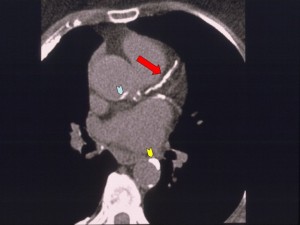
How to Prevent a Heart Attack (or Not) Part Two by David G. Porzio, M.D., FACC
 In my last article I discussed how difficult it is to actually prevent a heart attack. I emphasized the importance of recognition of symptoms related to heart disease and seeking appropriate care as the best way to limit the damage to the heart. I also described the various stress testing modalities available to the physician to help identify patients with symptoms suggestive of heart disease. I emphasized that performing these types of stress testing on asymptomatic patients does not facilitate the diagnosis of ASCVD or reduce the incidence of heart attack. In this article I want to educate the reader about X-ray imaging that is available to determine the presence of atherosclerotic changes in the coronary arteries in asymptomatic people; specifically Electron Beam Coronary Calcium scoring (EBCT).
In my last article I discussed how difficult it is to actually prevent a heart attack. I emphasized the importance of recognition of symptoms related to heart disease and seeking appropriate care as the best way to limit the damage to the heart. I also described the various stress testing modalities available to the physician to help identify patients with symptoms suggestive of heart disease. I emphasized that performing these types of stress testing on asymptomatic patients does not facilitate the diagnosis of ASCVD or reduce the incidence of heart attack. In this article I want to educate the reader about X-ray imaging that is available to determine the presence of atherosclerotic changes in the coronary arteries in asymptomatic people; specifically Electron Beam Coronary Calcium scoring (EBCT).
Atherosclerosis is an inflammatory disease of the blood vessels. The body’s immune system responds to the injury created by the deposition of cholesterol into the blood vessel walls by sending a form of white blood cell, the macrophage, into the growing plaque. The macrophage is a scavenger and essentially is there to “gobble-up” the cholesterol in the artery. In the process, the macrophage produces “inflammatory” byproducts. As the artery heals, calcium becomes embedded within the plaque. This “calcified artery” can then be seen on an EBCT scan.
The EBCT is a high resolution CT scan that is limited to just the heart. The image slices are very thin (< 10 mm), which allows the calcium to be visualized in the artery.
The amount of calcium in each artery can be calculated to achieve a coronary calcium score (CAC). There are some limitations to EBCT:
- It is a qualitative test in that only identifies calcium in the artery. If calcium is present then there is atherosclerosis but it does not determine if significant obstruction is present.
- The CAC score does not correlate to the degree of narrowing or obstruction. The calcium score does correlate to the risk of cardiovacular events at values > 400 Agaston.
- Atherosclerotic plaques are not always calcified. These so called “soft plaques” are actually more dangerous and prone to rupture and will not show up on an EBCT.
Regardless of these limitations, an EBCT can be a powerful tool with regards to identifying people with asymptomatic atheroscleosis.
Case Study (completely fictional): There is a 45 year old male with a father who died of a massive heart attack at age 52. He is concerned about suffering the same fate. He is in great physical shape and exercises regularly. He has no other cardiac risk factors. He has no symptoms of chest pain to suggest significant CAD. His cholesterol is elevated though, but based on current guidelines, does not require treatment.
A: This is a classic example of someone with clear genetic risk for ASCVD but does not demonstrate any symptoms. His cholesterol is elevated but his risk calculation does not warrant treatment unless ASCVD can be documented. He could quite possibly have a < 50% narrowing of an artery and not know it. Any stress testing previously described will almost certainly give a low risk result and his subclinical disease would go unrecognized and untreated. An EBCT in this setting would identify the presence of ASCVD. He would have a clear indication for treatment with a Statin medication for his cholesterol. A stress test could be performed to confirm he is at low risk in spite of his disease. Going forward, he and his doctors would know he has ASCVD and the threshold for invasive testing (angiogram)at the first sign of symptoms would be very low. An EBCT is the perfect test for this individual.
Now for the bad news about EBCT. Health insurance providers will not pay for it. That’s right, an ideal test that identifies people with atherosclerosis before they have had a heart attack and allows for early, aggressive treatment is not covered by the Blue Cross, Blue Shield or the Aetnas of the world. Fortunately, an EBCT is not a checkbook-breaking test. Orange county prices range from about $199 and up.
Coronary atherosclerosis is a rather insidious disease that is often not recognized until the person suffers a heart attack. In asymptomatic people, standard stress testing techniques have no validity and are not indicated. In those asymptomatic people with increased cardiovascular risk due to a family history, blood pressure, smoking, age an EBCT can identify the presence of calcified arteries. Once identified, appropriate risk factor reduction and treatment with Statin medications to lower cholesterol and slow the growth of the atherosclerotic plaques can be initiated. Knowledge is power and knowing you have even sub-clinical disease can lead to early intervention and limit the associated morbidity coronary atherosclerosis.
The information provided is for general interest only and should not be misconstrued as a diagnosis, prognosis or treatment recommendation. This information does not in any way constitute the practice of medicine, or any other health care profession. Readers are directed to consult their health care provider regarding their specific health situation. Marque Medical is not liable for any action taken by a reader based upon this information.

